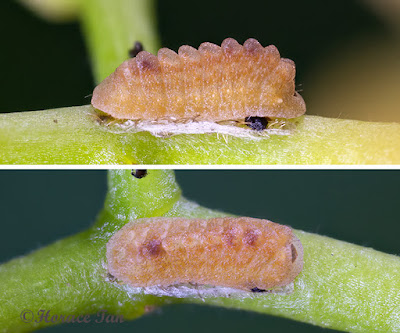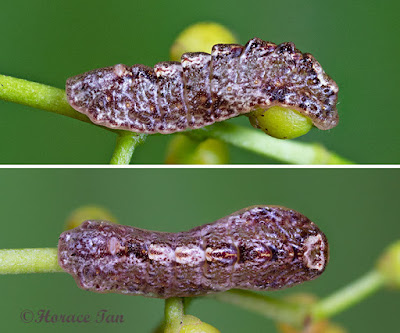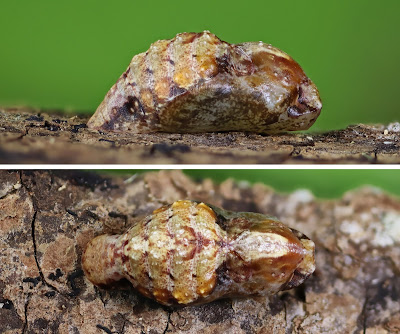Butterfly Biodata:
Genus: Rachana Eliot, 1978
Species: jalindra Horsfield, 1829
Subspecies: burbona Hewitson, 1878
Wingspan of Adult Butterfly: 30-34mm
Caterpillar Local Host Plant: Macrosolen cochinchinensis (Loranthaceae, common name: Common Chinese Mistleoe).
The underside of a male Banded Royal.
The upperside of a male Banded Royal.
Physical Description of Adult Butterfly:
On the upperside, the male is deep shining blue with black distal borders on both forewing and hindwing; the female is brown with black spots at the hindwing tornus and in space 2 surmounted by a narrow bluish grey area, and the black spots in spaces 1b and 2 lined with white patches. On the underside, both sexes are white with a broad brown distal border on both fore- and hindwings. A series of white-striae in the brown border separated it into two halves, with the outer half paler brown than the inner half. In the hindwing, there is a black tornal spot, a blush green patch in space 1b, a prominent orange-crowned black sub-marginal spot in space 2, and black post-discal striae in spaces 1b and 2. Each hindwing has a pair of black tails at ends of veins 1b and 2, with the one at vein 1b bordered with dense white cilia, and the one at vein 2 white-tipped.
The upperside of a female Banded Royal.
The underside of a female Banded Royal.
Field Observations:
The Banded Royal is rare in Singapore. It was only recently re-discovered in 2006 where a few individuals were sighted in an open area within the Central Catchment Nature Reserve. Since then, sightings of this species have mostly been confined to a few locations within the catchment nature reserve and in a western wasterland, and typically only a single individual appeared each time. The fast-flying adults have been sighted taking nectar at flowering plants.
Early Stages:
Across the distribution region of the Banded Royal, several plants in the Loranthaceae family have been identified as the larval hosts. In Singapore, thus far only one larval host plant has been identified. This local larval host is the Common Chinese Mistletoe (Macrosolen cochinchinensis ), a parasitic shrub with all parts of the plants glabrous (having no hairs, smooth). The leaves are leathery, opposite, ovate or lanceolate. On this plant, the early stages of the Banded Royal feed on the young leaves and developing fruits, with a strong preference for the latter.

Local host plant: Macroseolen cochinchinensis(Common Chinese Mistletoe).
A Banded Royal female laying an egg on a branch of the Chinese Mistletoe.
A freshly laid egg of the Banded Royal. Inset: an enlarged view of the egg.
Eggs are laid singly on the stem of the host plant, typically at the axil (angle/space between stem and branch, or between leaf and stem), or on a recess area or nook/crevice present on the stem. Each egg is about 0.8mm in diameter, white with a strong greenish tinge when freshly laid. It is bun-shaped with a depressed micropylar at the pole and a surface reticulated with rather large polygonal depressions.
Two vlews of an egg of the Banded Royal.
A fully developed egg with the caterpillar ready to emerge.
It takes about 3 days for the egg to hatch. The young caterpillar consumes just enough of the egg shell to emerge. It is pale yellowish brown in coloration, and has a length of about 1.1mm. Long setae (hairs) run along the length of the body dorsally as well as sub-spiracularly. Raised dorsal tubercles are transparent. A diamond-shaped black prothoracic shield is present. The 1st instar lasts about 3 days with the body length increased to about 2.1mm.
A newly hatched caterpillar next to its empty egg shell, length: 1.1mm.
Two views of a newly hatched caterpillar, length: 1.1mm.
Two views of a 1st instar caterpillar, length: 1.9mm.
A late 1st instar caterpillar of the Banded Royal, dormant prior to the moult to the next instar.
In the 2nd instar caterpillar, the dorsal tubercles are proportionately reduced in size, and the long dorsal setae seen in the 1st instar are now absent. The body base colour can either be reddish brown (red form) or green (green form). The caterpillar still features a black diamond-shaped prothoracic shield. The dorsum of the mesothorax and metamthorax are whitish, forming a prominent and trapezoidal patch. The dorsum of the 3rd to the 5th abdominal segements are also whitish, while that of the 1st, 2nd, 6th and 7th abdominal segements are dark reddish brown. The dorsal nectary organ is whitish and featured prominently on the dorsum of the 7th abdominal segment. The 2nd instar lasts for about 3 days, with the body length reaching up to 5.5-6.3mm.
A newly moulted 2nd instar caterpillar, eating its old skin.
Two views of a 2nd instar caterpillar of the Banded Royal, red form, length: 4.5mm.
Two views of 2nd instar caterpillar of the Banded Royal, green form, length:5.5mm.
Two views of a 2nd instar caterpillar, late in this stage, dormant prior to its moult, length:5.6mm.
In the 3rd instar, the markings on the dorsum of the caterpillar resemble those in the 2nd instar, but there is an additional pair of black dorso-lateral spots featured on the posterior segments. As in the 2nd instar, the body base colour can either be greenish or brownish. The dorsal nectary organ on the 7th abdominal segment and the tentacular organs on the 8th abdominla segment are now easily discernible.
Two views of a newly moulted 3rd instar caterpillar, eating its old skin.
Frontal view of a 3rd instar caterpillar, showing the black prothoracic shield, and the whitish patch on the mesothorax and metathorax.
Posterior segments of a 3rd instar caterpillar, showing the dorsal nectary organ on the 7th abdominal segment, and the tentacular organs on the 8th abdominal segment.
Two views of a 3rd instar caterpillar eating a developing fruit of the Chinese Mistletoe, with greenish body base colour, length: 7.5mm.
Two views of a 3rd instar caterpillar, with brownish body base colour, length: 10mm.
Two views of a 3rd instar caterpillar eating a developing fruit of the Chinese Mistletoe, with greenish body base colour, length: 11.5mm.
Two views of a 3rd instar caterpillar eating a developing fruit of the Chinese Mistletoe, with brownish body base colour, length: 12.5mm.
As the body grows to a length of around 12-13mm, the caterpillar stops feeding and comes to rest at a spot on the stem to prepare for the next moult. After about 3 days in the 3rd instar, the moult to the 4th and final instar takes place.
Two views of a late 3rd instar caterpillar, dormant prior to its moult to the final instar.
The 4th instar caterpillar resembles the 3rd instar caterpillar in most body features/markings, and is generally pale brown to greenish brown. In some individual specimens, the body colour can be mostly whitish in the abdominal segments. The prothoracic shield and the head are both black, as in the earlier instars. The 4th (and final) instar lasts about 5 days with the body length reaching up to 23mm.
Two views of a newly moulted 4th instar caterpillar, eating its old skin.
Frontal view of a 4th instar caterpillar, showing the black prothoracic shield, and the whitish patch on the mesothorax and metathorax.
Two views of a 4th instar caterpillar feeding on a developing fruit of the Chinese Mistletoe, length: 18mm.
Two views of a 4th instar caterpillar, length: 19mm.
Two views of a late 4th instar caterpillar, length: 23mm.
As it enters the pre-pupatory phase of its life cycle, the caterpillar ceases its feeding activity. Its body gradually shrinks in length and the colour turns pale brownish. The pre-pupatory caterpillar wanders around for up to 1-1.5 day in its quest for a suitable pupation site. Typically it settles for a spot on a surface which is partially concealed. At the chosen pupation site, it stays dormant for 1 day or so before spinning a silk pad to which it attaches itself via claspers at the posterior end.
Two views of a pre-pupa of the Banded Royal.
The pupation event for a Banded Royal caterpillar.
About 1 day after the pre-pupatory caterpillar secures itself to the pupation spot, pupation takes place. The pupa is held firmly via its cremaster to the silk pad on pupaton spot. It is 14.6 to 15.2mm in length, with the typical shape for a lycaenid pupa. It has a brown thorax with a whitish elongated dorsal patch on the mesothorax and metathorax, and pale yellow brown abdomihnal segments and brownish wing pads.
Two views of a pupa of the Banded Royal, length: 14.8mm.
Two views of a mature pupa of a female Banded Royal.
Two views of a mature pupa of a male Banded Royal.
Eleven to thirteen days later, the pupa becomes darkened in color signaling the imminent emergence of the adult. One can now tell the sex of the soon-to-emerge butterfly from the coloration of the wing pad at this stage (see pictures above). The next day the adult butterfly emerges from the mature pupa.
A female Banded Royal emerges from its pupal case.
A newly eclosed female Banded Royal resting next to its pupal case.
References:
- [C&P4] The Butterflies of The Malay Peninsula, A.S. Corbet and H.M. Pendlebury, 4th Edition, Malayan Nature Society, 1992.
- Butterflies of Thailand, Pisuth Ek-Amnuay, 2nd Edition, 2012.
- A Field Guide to the Butterflies of Singapore, Khew S.K., Ink On Paper Communications, 2nd Edition, 2015.









































No comments:
Post a Comment